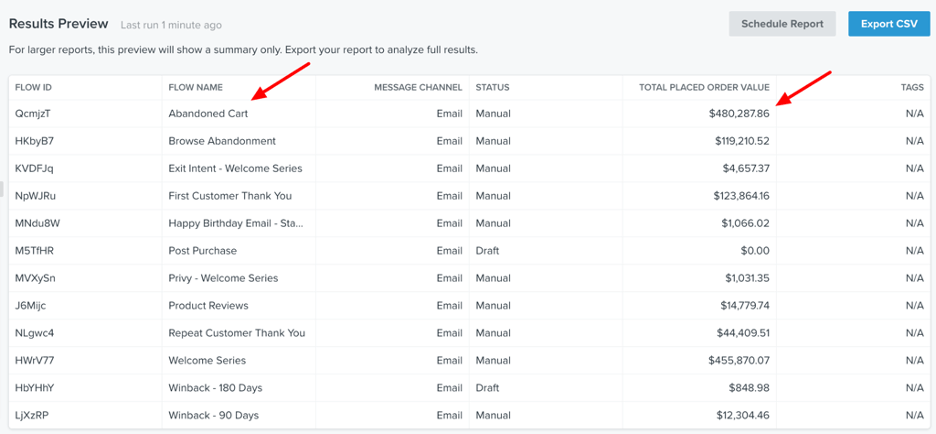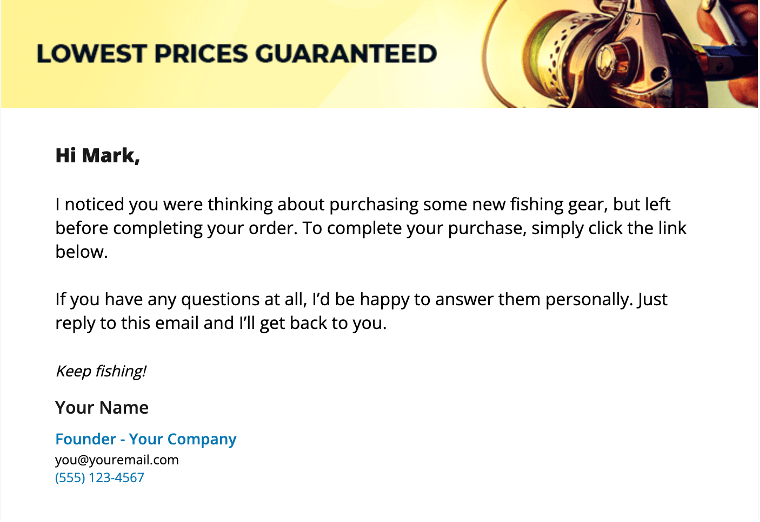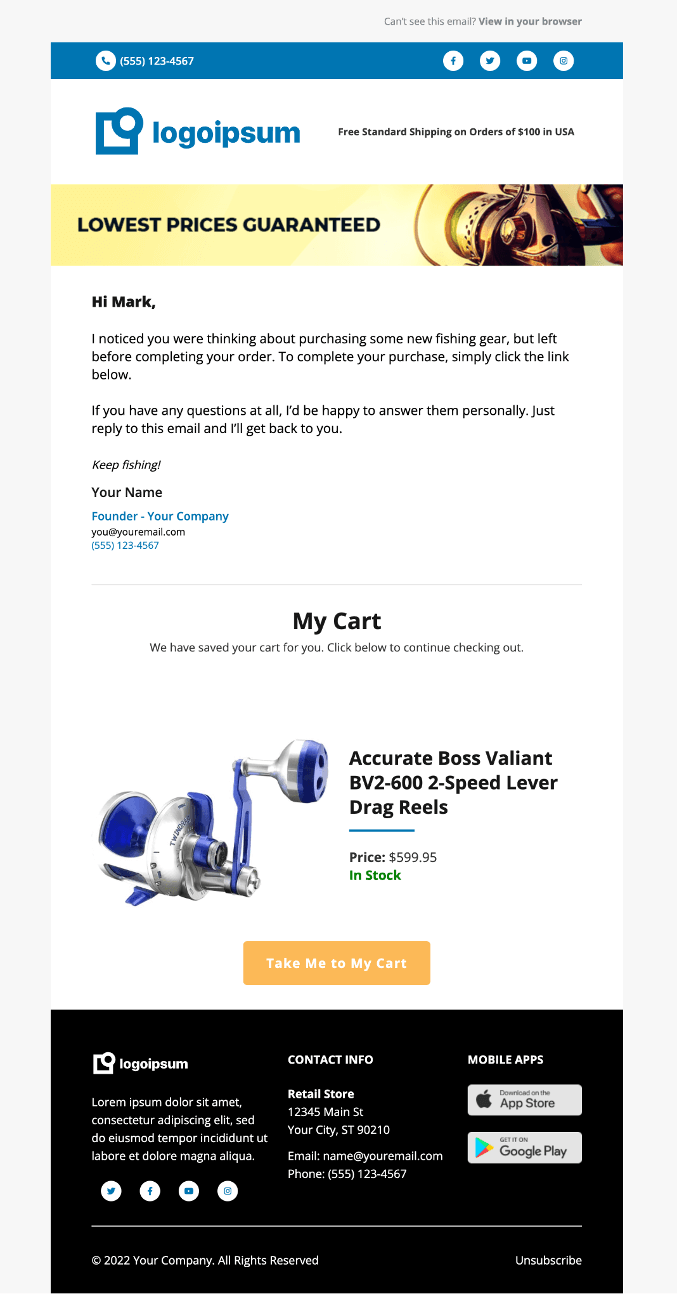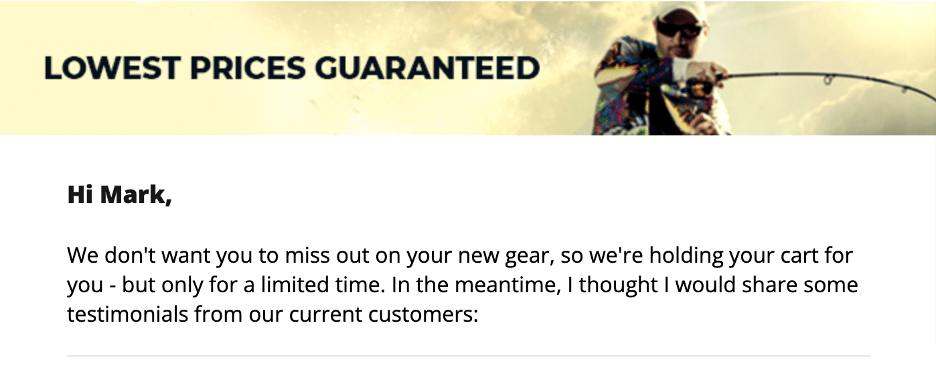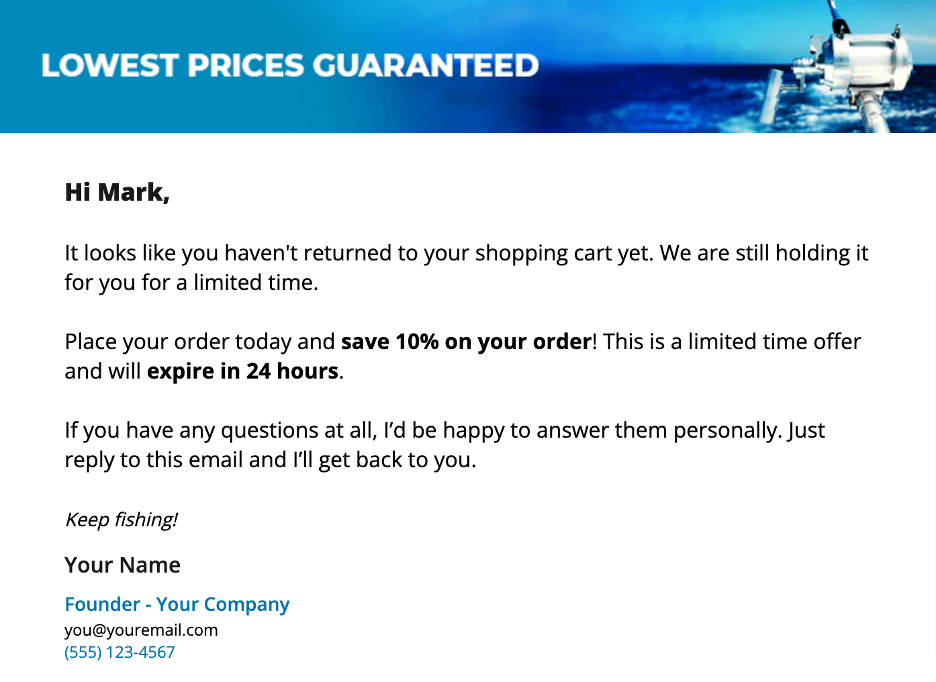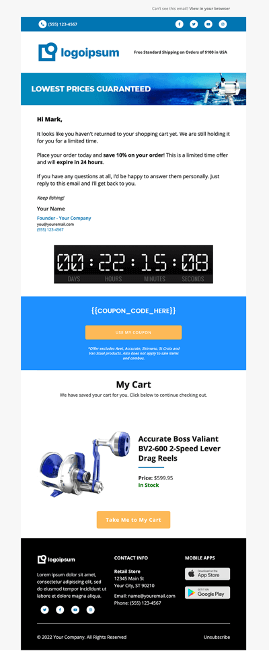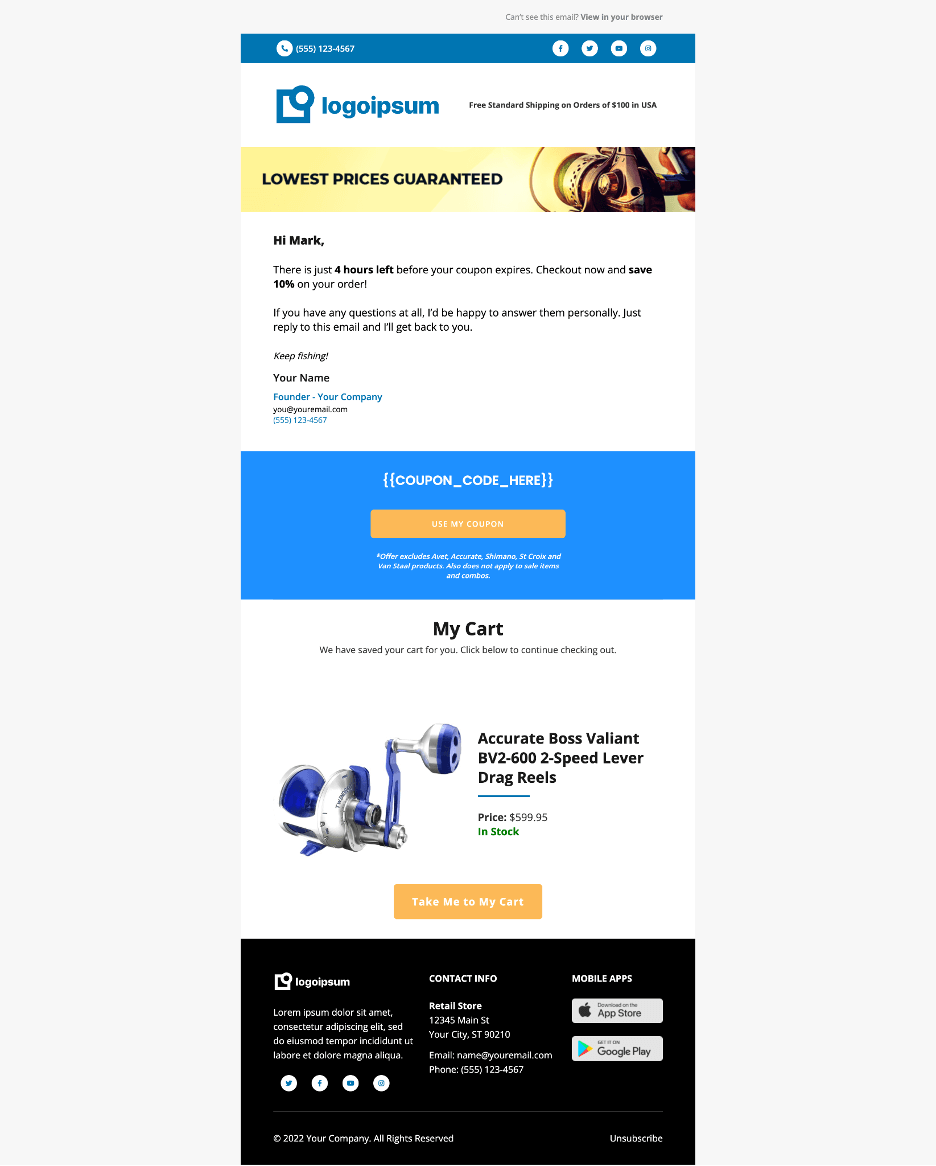The Hidden Cost Of Cart Abandonment: How To Recover Sales, Automatically
A step-by-step guide to recover lost eCommerce sales.
“Hi Mark – did you forget something?”
I have no idea who Mark actually is, but he received this email because he had abandoned his cart on one of my client’s sites, for one reason or another (life happens).
In fact, the average cart abandonment rate is just under 70 percent.
That means roughly 7 out of every 10 shoppers won’t complete their purchase on your website!
This is a massive opportunity to recover revenue that would otherwise be lost and recover it automatically.
Over the course of the next 7 days, Mark received 3 more emails from my automated cart abandonment email automation.
Fast forward to today, I’ve sent out this email sequence hundreds of times and have generated over $480,287.86 (and counting) for just one of our eCommerce clients.
Beating Cart Abandonment
This might seem obvious, but cart abandonment happens when shoppers add items to their cart with some intent of making a purchase on your website, but leave without going through the entire checkout process.
As I mentioned above, on average, cart abandonment for eCommerce sites is 69%, meaning that nearly 7 out of 10 potential buyers abandon their cart.
The Result of Cart Abandonment
eCommerce stores lose nearly $18 billion every year!
While cart abandonment is inevitable for all sites, there is a proven method for giving your eCommerce business the best chance of recovering these potential sales.
The reason this method works so well is that it targets customers who have already been converted from tire kickers to shoppers by adding the product to their cart.
Since we have no idea why they abandoned their cart, we leverage automatic emails to become salespeople for us through a cart abandonment automated email sequence.
What could be better than automatically recovering sales for your business, even if you are asleep?
This guide explains the entire process, step-by-step, and includes email templates that you can use for your own eCommerce store to potentially generate hundreds of thousands of dollars that could’ve been lost due to cart abandonment.
Let’s dive in.
The First Email: The Reminder
The reality is that cart abandonments happen for a variety of reasons, that’s why I like to start with just a simple friendly reminder.
It still amazes to me how often this happens and how well this simple reminder converts.
This first email is incredibly simple, yet it is one of the most effective emails I’ve ever sent out.
Let’s start with the subject line.
The First Email: Subject Line:
Hi Mark – did you forget something?
There are a couple of things that stand out immediately.
The first is personalization. Whenever possible, we try to include first names in subject lines to make the email feel personal. This isn’t always the case for all businesses and should be tested.
It is critical for this sequence that when you are collecting the contact information of customers and potential customers’, you collect their first name whenever possible.
While personalization in emails isn’t new, it is still one of the most effective conversion strategies.
According to Campaign Monitor:
“Emails with personalized subject lines are 26% more likely to be opened.”
With the second part of the subject line we want to create a bit of curiosity. People get a ton of email and it is critical to get the email noticed and opened.
By asking “did you forget something?”, we take advantage of natural human curiosity, and create a subtle sense of urgency.
The second part of the subject line implies that you’ve forgotten something which creates motivation to open the email.
The First Email: Content
Getting the email opened is just the first step. You also need to convince the buyer to take action (visit the website, buy something, download something, etc). Example below:
The body of the email is very important. You’ll notice above that I’ve used short sentences. That’s because long-paragraphs can be a death sentence for emails.
Think about your own email habits and how you go through your inbox.
If you’re anything like me, you move through your inbox as quickly as possible to get to 0 unread emails. If for some reason you love collecting unread emails you might want to see a therapist 😉
You’ll also notice I don’t mince words – I get right to the point by reminding the customer of their abandoned cart, and more importantly, that the owner of the business is available to answer any questions they have personally.
If possible, it is a good idea to humanize your brand and give it a “face.” This has been shown to establish trust.
If the customer got distracted and simply forgot to checkout, this email does a great job of reminding them to complete their purchase.
The First Email: Design
Below is an example of how we design the first abandon cart email:
Why This Email Works
Here are the key takeaways from the first email:
1. Personalized
I am a strong believer in personalizing emails and personalization is going to be a common theme in many of my emails because I’ve seen its effectiveness first-hand.
2. Timing
This email was sent exactly 4 hours after cart abandonment while the desired purchase was still fresh in the customer’s mind.
They most likely will still want that fishing gear, and it isn’t too late for the owner to answer any of their questions.
3. Direct
Keep it simple, easy to understand, and clear as to what action they took that triggered this email (abandoning their cart).
4. Relationship Building
The email offers a quick and easy way for the customer to contact the owner.
The Second Email: Social Proof
Humans have a herd mentality – doing what we see others do has helped us survive for thousands of years, and we haven’t abandoned the habit just yet.
The second email is sent out 20 hours after the first email (or 24 hours after cart abandonment) and is aimed at tapping into the customer’s herd mentality.
The Second Email: Subject Line
“They have great customer service and they will price-match!”
I know what you’re thinking – where is Mark?
Well, Mark isn’t in the subject line this time because we A/B tested using the customer’s name vs a snippet from a testimonial for this subject line and found that the latter generated 143% more revenue than the email with the personalized subject line.
And I have a pretty solid theory to explain why this happened.
20 hours ago they received an email with a personalized subject line.
If Mark received another email with a similar subject line, he may have thought that it was the same email, with the same content, and never opened it.
Changing up in the subject line prevents it from feeling spammy, while providing social proof and creating curiosity at the same time.
The Second Email: Content
Once the subject line has convinced the recipient to open the email, the real work begins with the body content.
The main purpose of this email was to address any concerns potential customers may have, especially if they haven’t purchased from the site before.
To this end, we have leveraged past customer testimonials.
Here’s what the body of the email looks like:
Like the first email, this email also includes a list of the items the customer currently has in their cart.
We’ve also added an element of urgency by setting a time limit on how long we’ll be holding their cart for them.
This works especially well if the item they were considering is almost out of stock or in high demand.
Here is the full email with social proof:
Why This Email Works
Here are the key takeaways from the second email:
1. Timing
Timing is crucial for this cart abandonment email. We want to give the customer enough time to think about their desired purchase, but not so much time that they completely forget about it or buy from a competitor.
Our testing found that sending it any time before 20 hours was too soon – more often than not, the customer didn’t open the email.
2. Social Proof Subject Line
Again, the key with any email is to get it opened. A personalized subject line similar to the first email didn’t perform nearly as well, or create as much curiosity, as a completely new subject line using a snippet from a testimonial.
3. The Content
The first few lines of text, the testimonials, and the snapshot of the cart did three things – created a sense of urgency (“for a limited time”), activated the herd mentality of the human mind (testimonials), and reminded the customer of their desires (their cart).
The Third Email: The Discount
2 emails and 3 days after the cart abandonment, I sent out the third email in this sequence – including a coupon this time, because who doesn’t like a discount?
With the past emails, we gave our customers a chance to discard any doubts they may have by providing direct access to the store owner and by demonstrating the positive experiences of other customers.
If they still haven’t made a purchase, it’s safe to assume that price might be a factor so this time, we offer them a 10% discount.
The Third Email: Subject Line
Mark – a little something for you…
Again, we A/B tested subject lines, comparing non-personalized and personalized subject lines, and this time the personalized emails came out on top.
This was likely due to the longer time period between the second and third emails.
This time, however, the second part of the subject line was far more important than the personalized greeting- immediately letting the customer know that we’re offering a discount on their order.
Remember, the main purpose of the subject line is to get the customer to open the email. Click-through rates and conversions come with the body of the email.
The Third Email: Content
The human attention span is very short, which means short paragraphs will almost always be more effective when delivering a sales pitch (or sales message).
With that mind, we’ve included three very short paragraphs in the body of this email, each communicating a different message.
The first paragraph is the intro and instantly lets the customer know that this email is about their shopping cart.
This, in combination with the direct subject line, is enough for the customer to understand the main points of the email.
But we’re not done yet.
In the second paragraph, we create urgency and provoke action with the sentence “This is a limited time offer and will expire in 24 hours.”
The final paragraph is yet another opportunity to open a two-way dialogue with the customer, in case they have any doubts.
Apart from the text, we’ve also included a few design elements, the most obvious of which is the countdown timer gif and, of course, the coupon itself.
Why This Email Works
Here are the key takeaways from the third email:
1. Incentive
There are two main reasons why this works and the first is, of course, the incentive.
I have no doubt that the financial incentive of this 10% discount was crucial in the success of this email sequence, which generated nearly $100,000 in sales.
On the topic of incentives, it’s important to know your audience.
If you’re selling a luxury item (or something similar), beware of offering too many discounts which might devalue the brand in the eyes of the customer.
2. Fear of Missing Out
The second reason this email works is because of the limited-time offer.
We decided on 24 hours because we wanted to create a sense of urgency but give the customer more than enough time to take action.
But what if the customer is busy when he receives the email and forgets about it?
That’s what the final email is for…
The Final Email: Urgency
Last call.
The final email in this sequence is meant to remind customers who might’ve forgotten to use the coupon or missed the third email altogether.
Subject Line:
Mark – just 4 hours left to use your coupon!
This final email has a personalized subject line because it performed well during A/B testing.
Just like the other emails, we’ve kept the subject line as direct and as intriguing as possible.
But unlike the other emails, this email creates a sense of urgency right in the subject line instead of the body because it represents the customer’s final chance at a discount.
In 4 hours, they will miss their opportunity to save 10% on their order.
The Final Email: Content
No hard-sell on the last email (we did that in the third email). If the customer saw and ignored the previous email, they’re unlikely to suddenly change their mind this time (though it’s still possible).
Instead, this email is meant for two audiences: Those who wanted to make a purchase but forgot to finalize it, and those who missed the third email.
Why This Email Works
Here are the key takeaways from the fourth and final email:
1. Urgency and Fear of Missing Out
We found four hours to be the sweet spot for reminders. Four hours created a sense of urgency while giving customers just enough time to make a purchase, especially if they are at work.
2. Short and Sweet
As I said, there’s no point in another hard-sell in the final email. Pushing too hard can risk coming off as annoying or forceful.
As eCommerce store owners, you did everything you could, now let the customer make a decision. Keep this email short and sweet.
Free Revenue Optimization Audit
Are you looking for ways to increase your revenue, automatically?
We can help! Our team of experts will work with you to identify areas of your sales funnel that need improvement and create a detailed plan of action.
You won’t want to miss out on this opportunity – click here to apply for a free revenue optimization strategy session today. You’ll be glad you did.
Fill out our short application form and one of our experts will be in touch soon!

